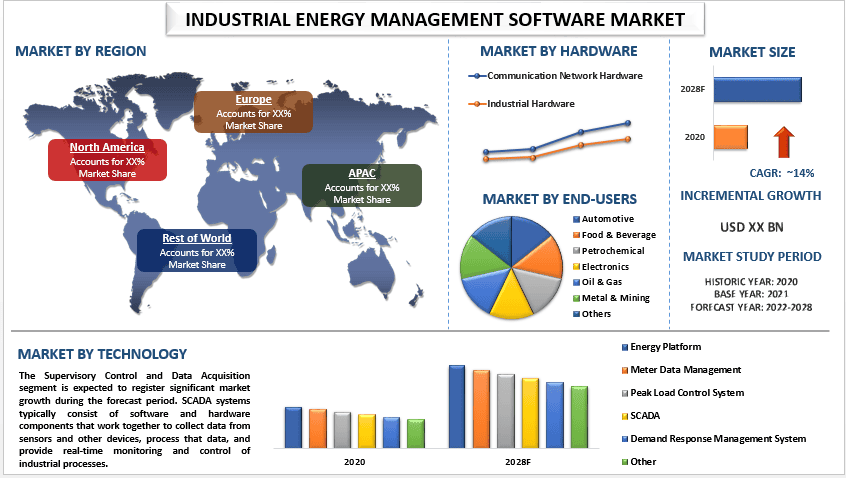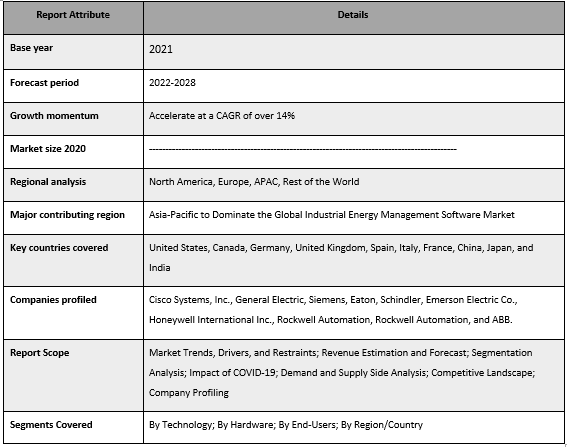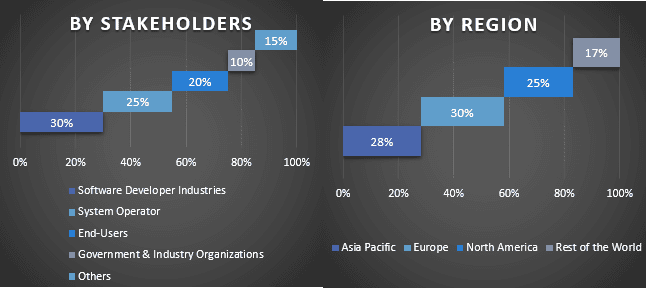- Home
- About Us
- Industry
- Services
- Reading
- Contact Us
Industrial Energy Management Software Market: Current Analysis and Forecast (2022-2028)
Emphasis on Technology (Energy Platforms, Meter Data Management, Peak Load Control System, SCADA, Demand Response Management System, and Others); Hardware (Communication Network Hardware and Industrial Hardware); End-Users (Automotive, Food & Beverage, Petrochemical, Electronics, Oil & Gas, Metal & Mining, and Others); and Region/Country

Global Industrial Energy Management Software Market is expected to grow at a significant rate of around 14% during the forecast period. The Industrial Energy Management Software (IEMS) market refers to the software solutions designed to help businesses manage their energy consumption, optimize their energy usage, and reduce their energy costs. IEMS software provides a platform for businesses to monitor and analyze their energy consumption, identify inefficiencies, and implement energy-saving measures. In recent times, the industrial energy management software market has witnessed significant demand driven by increasing demand for energy-efficient solutions, rising energy costs, and government regulations aimed at reducing carbon emissions. In addition, the rise of smart manufacturing and the Internet of Things (IoT) has also contributed to the growth of the market, as companies seek to leverage real-time data to optimize their energy usage.
Cisco Systems, Inc., General Electric, Siemens, Eaton, Schindler, Emerson Electric Co., Honeywell International Inc., Rockwell Automation, Rockwell Automation, and ABB are some of the key players in the market. Several M&As along with partnerships have been undertaken by these players to facilitate customers with hi-tech and innovative products/technologies.
Insights Presented in the Report
“Amongst hardware, industrial hardware category to witness significant market growth during the forecast period”
Based on the hardware, the market is bifurcated into communication network hardware and industrial hardware. The industrial hardware segment is expected to witness a significant CAGR during the forecast period. Industrial hardware refers to the physical equipment and devices used in industrial settings for various purposes such as manufacturing, processing, and automation. This includes a wide range of machinery, tools, and instruments designed for specific tasks. Additionally, the increasing industrialization around the world will propel the demand for testing and measuring, material handling, and others for optimum efficiency and are expected to support the market growth for the industrial hardware segment.
“Amongst end-users, the oil & gas to hold a significant CAGR in the market in 2021”
Based on end-users, the market is segmented into automotive, food & beverage, petrochemical, electronics, oil & gas, metal and mining, and others. The oil & gas segment is expected to register a significant CAGR during the forecast period owing to the increasing demand for fossil fuels around the world. The increasing demand for fossil fuels requires industries to optimize their energy use and operational activities along with environmental sustainability. Also, industrial energy management software is used for predictive maintenance, and energy efficiency analysis as well as for real-time performance monitoring and is expected to support the demand for industrial energy management software.
Industrial Energy Management Software Market Report Coverage

“North America to hold a significant share in the market.”
In 2021, North America held a significant share of the global industrial energy management software market. This is mainly due to a large number of industrial facilities in the country and the increasing demand for energy-efficient solutions. Also, the increasing demand for cloud-based energy systems that helps industries in a comprehensive view of their energy usage, allowing them to identify opportunities for energy savings and improve their overall energy efficiency. These systems typically provide detailed analytics and reporting, allowing users to track energy usage over time and identify trends and anomalies. As industrial energy management software helps companies monitor and optimize their energy usage, reduce costs, and improve their overall energy efficiency along with the integration with other systems, such as building management systems, to provide a comprehensive view of energy usage and performance and is expected to support market growth in the region.
Reasons to buy this report:
- The study includes market sizing and forecasting analysis validated by authenticated key industry experts.
- The report presents a quick review of overall industry performance at one glance.
- The report covers an in-depth analysis of prominent industry peers with a primary focus on key business financials, product portfolio, expansion strategies, and recent developments.
- Detailed examination of drivers, restraints, key trends, and opportunities prevailing in the industry.
- The study comprehensively covers the market across different segments.
- Deep dive regional level analysis of the industry.
Customization Options:
The global industrial energy management software market can further be customized as per the requirement or any other market segment. Besides this, UMI understands that you may have your own business needs, hence feel free to connect with us to get a report that completely suits your requirements.
Table of Content
Research Methodology for the Industrial Energy Management Software Market Analysis (2022-2028)
Analyzing the historical market, estimating the current market, and forecasting the future market of the global industrial energy management software market were the three major steps undertaken to create and analyze the adoption of industrial energy management Software in major regions globally. Exhaustive secondary research was conducted to collect the historical market numbers and estimate the current market size. Secondly, to validate these insights, numerous findings and assumptions were taken into consideration. Moreover, exhaustive primary interviews were also conducted, with industry experts across the value chain of the global industrial energy management software market. Post assumption and validation of market numbers through primary interviews, we employed a top-down/bottom-up approach to forecasting the complete market size. Thereafter, market breakdown and data triangulation methods were adopted to estimate and analyze the market size of segments and sub-segments of the industry pertains to. Detailed methodology is explained below:
Analysis of Historical Market Size
Step 1: In-Depth Study of Secondary Sources:
Detail secondary study was conducted to obtain the historical market size of the industrial energy management software market through company internal sources such as annual reports & financial statements, performance presentations, press releases, etc., and external sources including journals, news & articles, government publications, competitor publications, sector reports, third-party database, and other credible publications.
Step 2: Market Segmentation:
After obtaining the historical market size of the industrial energy management software market, we conducted a detailed secondary analysis to gather historical market insights and share for different segments & sub-segments for major regions. Major segments are included in the report as technology, hardware, and end-users. Further country-level analyses were conducted to evaluate the overall adoption of testing models in that region.
Step 3: Factor Analysis:
After acquiring the historical market size of different segments and sub-segments, we conducted a detailed factor analysis to estimate the current market size of the industrial energy management software market. Further, we conducted factor analysis using dependent and independent variables such as various technology, hardware, and end-users of industrial energy management software. A thorough analysis was conducted for demand and supply-side scenarios considering top partnerships, mergers and acquisitions, business expansion, and product launches in the industrial energy management software market sector across the globe.
Current Market Size Estimate & Forecast
Current Market Sizing: Based on actionable insights from the above 3 steps, we arrived at the current market size, key players in the global industrial energy management software market, and market shares of the segments. All the required percentage shares split, and market breakdowns were determined using the above-mentioned secondary approach and were verified through primary interviews.
Estimation & Forecasting: For market estimation and forecast, weights were assigned to different factors including drivers & trends, restraints, and opportunities available for the stakeholders. After analyzing these factors, relevant forecasting techniques i.e., the top-down/bottom-up approach were applied to arrive at the market forecast for 2028 for different segments and sub-segments across the major markets globally. The research methodology adopted to estimate the market size encompasses:
- The industry’s market size, in terms of revenue (USD) and the adoption rate of the industrial energy management software market across the major markets domestically
- All percentage shares, splits, and breakdowns of market segments and sub-segments
- Key players in the global industrial energy management software market in terms of products offered. Also, the growth strategies adopted by these players to compete in the fast-growing market
Market Size and Share Validation
Primary Research: In-depth interviews were conducted with the Key Opinion Leaders (KOLs) including Top Level Executives (CXO/VPs, Sales Head, Marketing Head, Operational Head, Regional Head, Country Head, etc.) across major regions. Primary research findings were then summarized, and statistical analysis was performed to prove the stated hypothesis. Inputs from primary research were consolidated with secondary findings, hence turning information into actionable insights.
Split of Primary Participants in Different Regions

Market Engineering
The data triangulation technique was employed to complete the overall market estimation and to arrive at precise statistical numbers for each segment and sub-segment of the global industrial energy management software market. Data was split into several segments & sub-segments post studying various parameters and trends in the areas of type, drive type, and application in the global industrial energy management software market.
The main objective of the Global Industrial Energy Management Software Market Study
The current & future market trends of the global industrial energy management software market were pinpointed in the study. Investors can gain strategic insights to base their discretion for investments on the qualitative and quantitative analysis performed in the study. Current and future market trends determined the overall attractiveness of the market at a regional level, providing a platform for the industrial participant to exploit the untapped market to benefit from a first-mover advantage. Other quantitative goals of the studies include:
- Analyze the current and forecast market size of the industrial energy management software market in terms of value (USD). Also, analyze the current and forecast market size of different segments and sub-segments
- Segments in the study include areas of technology, hardware, and end-users.
- Define and analysis of the regulatory framework for the industrial energy management software
- Analyze the value chain involved with the presence of various intermediaries, along with analyzing customer and competitor behaviors of the industry.
- Analyze the current and forecast market size of the industrial energy management software market for the major region.
- Major countries of regions studied in the report include Asia Pacific, Europe, North America, and the Rest of the World.
- Company profiles of the industrial energy management software market and the growth strategies adopted by the market players to sustain in the fast-growing market.
- Deep dive regional level analysis of the industry
Related Reports
Customers who bought this item also bought










